Minimum unit pricing of alcohol : final business and regulatory impact assessment
Underlines the rationale for minimum unit pricing from health and economic perspectives, setting out anticipated costs and benefits for all parties affected by a minimum price of 50 pence per unit.
5. Objective
5.1. Since the publication of our Framework, progress has been made in tackling alcohol misuse. However, the Scottish Government considers that the scale of alcohol problems in Scotland is such that further action is required if we are to reduce alcohol-related harm. Whilst recognised as a problem across the UK, the evidence shows that alcohol-related harm through alcohol misuse is greater in Scotland (see paragraphs 5.43 and 5.44). Despite an economic recession, austerity and investment in prevention and treatment initiatives in Scotland, consumption and harm remain at levels higher than in the early 1980s. We need a cultural change in order to influence future attitudes and relationships with alcohol, and bold, effective measures are required in order to trigger these changes. The policy aim of minimum pricing is to reduce alcohol-related harm by acting in two ways: to reduce, in a targeted way, the consumption of alcohol by consumers whose consumption is hazardous or harmful, and also to reduce the overall population level of consumption of alcohol. The policy will target a reduction in consumption of cheaper alcohol relative to its strength, and evidence shows that this type of product is more favoured by hazardous and harmful drinkers.
5.2. Prior to the revision of the guidance on risks [62] associated with drinking alcohol which resulted in the UK Chief Medical Officers’ ( CMOs) advice on low risk drinking levels, published in 2016 [63] , data on consumption and harm categorised drinkers into three groups – moderate, hazardous and harmful:
- Moderate drinkers: those drinking no more than 21 units [64] per week for men and no more than 14 units per week for women.
- Hazardous drinkers: between 21 and 50 units per week for men and between 14 and 35 units per week for women.
- Harmful drinkers: more than 50 units per week for men and more than 35 units per week for women.
5.3. Most of the analyses and data used to support minimum pricing in this document (and throughout the Judicial Review process) was carried out using this typology. The terms hazardous and harmful illustrate the increasing risk of harm as the amount of alcohol consumed increases. The new guidelines now refer to a lower risk threshold, for both men and women, of 14 units per week. Under the new guidelines, hazardous and harmful drinkers means those drinking at levels associated with a higher risk of alcohol-related harm, i.e. those drinking more than 14 units per week.
5.4. The low price of high strength alcohol is now part of the culture that has to be addressed, and this cannot be tackled without addressing price. Culture is a result of a complex and dynamic interaction of legislation, formal and informal controls, general and specific environmental influence and personal belief systems. The increasing levels of alcohol-related harm in recent decades demonstrates that education alone is not a powerful enough tool to change behaviour and culture. We already know from experience on seatbelts and on smoking in public places that such culture change is possible, and that legislation can make a significant contribution by encouraging changes in behaviour.
5.5. We recognise that no single action will bring about cultural change, which is why our Framework for Action sets out a package of over 40 measures. We are firmly of the view that minimum pricing is a key measure in the Framework and, without it, we will be unable to address the historic rates of alcohol-related harm and change our relationship with alcohol.
5.6. We are not alone in seeing the potential public health, social and economic gains from introducing a mechanism to increase the price of alcohol. The WHO report Alcohol: No ordinary commodity [65] , published in 2003, covering a review of 32 alcohol strategies and interventions found that, considering the degree of effectiveness, the breadth of research support, the extent to which they have been tested cross-culturally and the relative expense of implementation, the most effective alcohol policies include alcohol control measures (price and availability), drink-driving laws, and brief interventions for hazardous and harmful drinkers. At the other end of the spectrum, those alcohol policies for which it was difficult to find a direct positive effect on drinking patterns or problems include education in schools, public service announcements and voluntary regulation by the alcohol industry. WHO has recommended that, if these latter measures are used, they should form only part of a comprehensive strategy to tackle alcohol-related harm. We consider that the introduction of minimum pricing will have a high impact on reducing harm, through a reduction in consumption, because it involves changes in the pricing of alcohol.
5.7. The WHO’s Global Strategy on Alcohol [66] , published in 2010, adds to this by acknowledging the link between affordability and consumption and concludes that “increasing the price of alcoholic beverages is one of the most effective interventions to reduce harmful use of alcohol” and encourages Member States to consider implementing minimum pricing.
5.8. In addition, the UK’s National Institute for Health and Clinical Excellence ( NICE), commissioned by the UK Government, published public health guidance on the prevention and early identification of alcohol-use disorders in adults and adolescents in June 2010. The guidance , Alcohol-use disorders: preventing harmful drinking [67] , set out a number of recommendations including consideration of introducing a minimum price per unit. NICE further advises that the unit price should be reviewed regularly to ensure alcohol does not become more affordable over time.
5.9. The Scottish Government has used other legislative measures over recent years to tackle alcohol misuse. The Licensing (Scotland) Act 2005 (the “2005 Act”), which came fully into force in September 2009, introduced a new licensing system setting out five objectives, tackling under-age drinking, and cracking down on binge drinking. It largely focused on the on-sales environment and availability of alcohol with irresponsible drinks promotions, such as quantity discounts, in the on-trade being banned and a ‘premises by premises’ approach to opening hours. The Alcohol etc. (Scotland) Act 2010 (the “2010 Act”), which came into force in October 2011, focussed on the off-sales environment. The main measures in the 2010 Act are a ban on quantity discounts in off-sales that encourage customers to purchase more than they might have; a restriction on where material promoting alcohol may be displayed; the involvement of health boards in licensing issues; and a requirement for an age verification policy which is to be set at a minimum of age 25. The first of these, the quantity discount ban, replicates what was already in place for the on-trade environment through the 2005 Act.
5.10. Other legislation includes reducing the drink driving limit from 80mg of alcohol per 100ml of blood to 50mg of alcohol per 100 ml of blood, with equivalent changes to the limits for alcohol in breath or urine, from December 2014. In 2017, the Air Weapons and Licensing (Scotland) Act 2015 brought in provisions to further protect children and young people from underage drinking.
5.11. The Scottish Government’s original intention had been to introduce a ban on quantity discounts in the off-trade together with minimum pricing in the 2010 Act, as it was considered that, without minimum pricing alongside a quantity discount ban, retailers could offer straight discounts from list prices by simply lowering the price of individual alcohol products. Indeed, after the 2010 Act had come into force, retailers sold individual bottles of wine for £3.33, where previously they sold them as a multi-buy of three bottles for £10. Without a minimum price, retailers are able to offer straight discounting [68] as low as they wish as there is no ‘floor’ price. Minimum pricing was not supported during the passage of the previous Alcohol etc. (Scotland) Bill 2010.
5.12. NHS Health Scotland carried out a review [69] of the quantity discount ban and found that it was associated with a 2.6% reduction in consumption. Using different methodology, another study found no impact [70] . A recent paper [71] concluded that the implementation of the 2010 Act in Scotland in October 2011, although probably associated with a fall in off-trade alcohol sales in the year after its implementation, has not been clearly associated with a reduction in alcohol-related deaths or hospital admissions in the three-year period since. Arguably, the quantity discount ban will only be able to achieve its maximum effectiveness when working in conjunction with a minimum unit price.
Minimum price per unit of alcohol
5.13. The Scottish Government is proposing that alcohol must not be sold on licensed premises at a price below its minimum price. This will be a mandatory condition for all premises and occasional licences issued under the 2005 Act.
5.14. The formula for calculating the minimum price of alcohol is set out in section 1 of the Act. The minimum price of alcohol takes account of the strength of alcohol, which is determined by the Alcohol By Volume ( ABV) measure, and the volume of the alcohol in litres. The formula for calculating the minimum price will apply to all products equally, regardless of whether the products are domestically produced or imported, or whether sold in the on-trade or the off-trade.
5.15. The minimum price for a product is calculated as follows:
price per unit of alcohol x strength of product ( ABV) x volume of product x 100*
* Note: the need to multiply by 100 is because ABV is expressed as a percentage
For example, for a 50p minimum price, a standard sized bottle of spirits (70cl) at 40% ABV would be £14.00 (0.50 x 40.0/100 x 0.7 x 100). A bottle of wine (75cl) at 12% would be £4.50 (0.50 x 12.0/100 x 0.75 x 100).
Rationale for Government intervention
5.16. The Scottish Government’s National Performance Framework [72] provides a clear vision for Scotland with broad measures of national wellbeing covering a range of economic, health, social and environmental indicators and targets. The Scottish Government's Purpose sets out the direction and ambition for Scotland, which is to focus government and public services on creating a more successful country, with opportunities for all of Scotland to flourish, through increasing sustainable economic growth.
5.17. Building a healthy and sensible relationship with alcohol will significantly contribute to realising our Purpose and four out of five of our Strategic Objectives. We must help and support people to make better choices about alcohol if we are to attain our ambitions for Scotland. There is strong evidence that increases in health harms over recent decades have been driven by increased consumption and that this, in turn, is driven by the price and affordability of alcohol. That is why the introduction of a minimum price per unit of alcohol is an essential component of our alcohol strategy.
5.18. Scotland’s Economic Strategy [73] supports our Purpose to create a more successful country, with opportunities for all of Scotland to flourish, through increasing sustainable economic growth, by focusing on two main pillars to achieving this objective: increasing competitiveness and tackling inequality. In order that everyone in Scotland can enjoy the opportunities that economic growth provides, it is vital to boost the competitiveness of the Scottish economy. Over the long-term, increased levels of productivity are essential to support the economic growth needed to ensure rising living standards. Promoting competitiveness and addressing inequality are important interdependent ambitions; reducing inequality in itself is beneficial for economic growth.
5.19. Underpinning the Government's Purpose and Economic Strategy are five Strategic Objectives: to make Scotland Wealthier and Fairer, Safer and Stronger, Healthier, Smarter and Greener. Tackling alcohol misuse contributes to four out of the five objectives.
Wealthier & Fairer – Enable businesses and people to increase their wealth and more people to share fairly in that wealth. Developing a more mature and balanced relationship with alcohol will reduce the burden of alcohol misuse on business, public services and our most deprived communities, and thus contribute to a Wealthier and Fairer Scotland.
Safer & Stronger – Help local communities to flourish, becoming stronger, safer places to live, offering improved opportunities and a better quality of life.
Reducing consumption and alcohol misuse in Scotland will help to underpin the development of more resilient, cohesive and successful communities – by tackling alcohol misuse, we will be able to reduce crime and anti-social behaviour, making Scotland Safer and Stronger.
Healthier – Help people to sustain and improve their health, especially in disadvantaged communities, ensuring better, local and faster access to health care.
Adopting a balanced approach to alcohol will contribute to increased physical and mental wellbeing amongst Scots, especially in our most disadvantaged communities, making Scotland Healthier.
Smarter – Expand opportunities for Scots to succeed from nurture through to life-long learning, ensuring higher and more widely shared achievements. Preventing young people misusing alcohol and enabling them to make positive choices and fulfil their potential while addressing the effects of alcohol misuse within families will make Scotland Smarter.
5.20. The Strategic Objectives themselves are supported by 16 National Outcomes, which describe in more detail what the Scottish Government wants to achieve. Policies to tackle alcohol misuse will make a positive contribution to delivering half of our published National Outcomes:
- we live longer and healthier lives;
- we have tackled the significant inequalities in Scottish society;
- we have strong, resilient and supportive communities where people take responsibility for their own actions and how they affect others;
- we live our lives safe from crime, disorder and danger;
- we realise our full economic potential with more and better employment opportunities for our people;
- our young people are successful learners, confident individuals, effective contributors and responsible citizens;
- we have improved the life chances for children, young people and families at risk; and
- our children have the best start in life and are ready to succeed.
5.21. In addition, in recognition of the need to build a healthier relationship with alcohol in pursuit of our objectives, we also have a specific national indicator, related to excessive consumption, to reduce alcohol-related hospital admissions.
Alcohol-related harm in Scotland: the scale of the problem
5.22. Alcohol is not an ordinary commodity – it is a psychoactive and potentially toxic and addictive substance and is a contributory factor in around fifty different causes of death, ranging from cancers and strokes to assaults and road deaths [74, 75] . The most recent estimate indicates that alcohol consumption accounts for 8% of the total burden of disease in Scotland (as expressed in Disability Adjusted Life Years ( DALYs)). This includes, in 2015, 3,705 deaths and 41,161 adults admitted to hospital at least once [76] .
5.23. The harms are not limited to health and not experienced solely by the drinker. Damage can, and does, occur to family and friends, communities, employers and Scotland as a whole. Alcohol misuse acts as a brake on Scotland’s social and economic growth, costing an estimated £2.5 billion to £4.6 billion in 2007, with a midpoint estimate of £3.6 billion [77] . For the midpoint estimate, this includes around £870 million in lost productivity, a cost of around £270 million to the NHS and around £730 million in crime costs.
Consumption
5.24. It is well established that harms attributable to alcohol are related to both the quantity of alcohol consumed and the pattern of drinking [78] . Accurate data with which to estimate per capita alcohol consumption are vital to quantify the relationship between alcohol consumption and consequent harms, to design appropriate policy measures to minimise adverse alcohol-related health and social effects and to evaluate the effects of any policy or other changes on alcohol consumption.
5.25. WHO advises that the volume of alcohol use in a country is best estimated from national sales, production and/or taxation data, since population surveys invariably underestimate total alcohol consumption [79,80] . These can come from sales data and supply data (e.g. data on production and trade such as Food and Agriculture Organization of the United Nations ( FAO) and World Drink Trends ( WDT)) [81] or tax receipts, e.g. Her Majesty’s Revenue and Customs ( HMRC) data in the UK.
5.26. The most recent monitoring report from NHS Health Scotland shows that, as a nation, Scotland continues to buy enough alcohol for every adult in Scotland to substantially exceed the low risk weekly drinking guideline of 14 units [82] . In 2016, 10.5 litres (L) of pure alcohol were sold per adult in Scotland. This is equivalent to 20.2 units of pure alcohol per adult per week. It is 17% higher, per adult, than in England and Wales (equivalent to 1.5L pure alcohol per adult).
5.27. The volume of pure alcohol sold per adult in Scotland increased through the 1990s and early 2000s, stabilised between 2005 and 2009, and then declined until 2013. It then increased for two years before returning to a similar level as in 2013 (this can be seen in Figure 1). Despite the slight decrease from 2015 to 2016, there is persistently higher consumption in Scotland per head of population than in England and Wales.
Figure 1: Volume of pure alcohol (Litres) sold per adult (16+): Scotland and England & Wales 1994-2016 [83]
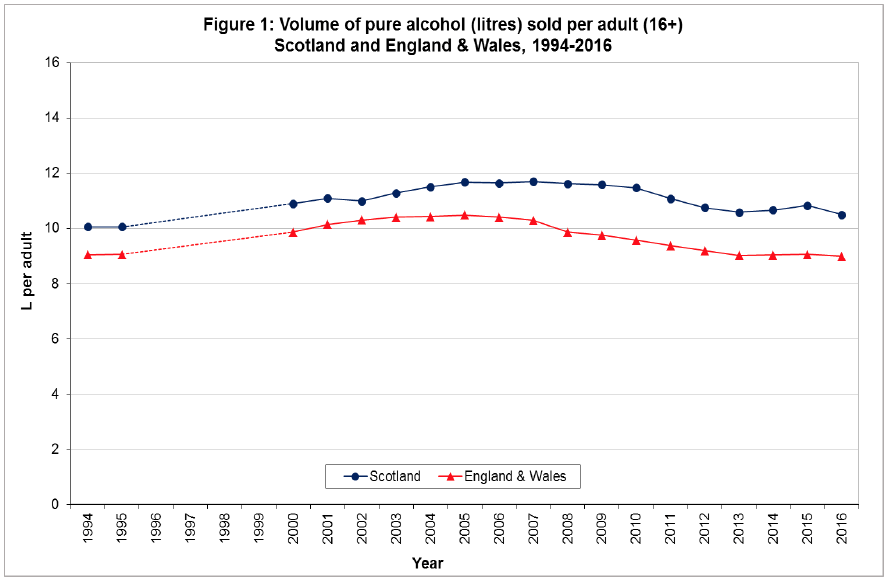
5.28. Over time, the prevalence of non-drinkers in Scotland has been increasing. This results in a much higher level of consumption if sales are expressed per adult drinker (12.5L) rather than per adult (10.5L).
5.29. A study by NHS Health Scotland on the validity and reliability of alcohol industry sales data found that these data provide a robust measure of population consumption in Scotland. The data are subject to typical under and over-estimating influences [84] and, in the 2010 data, the range of uncertainty was estimated to be from an overestimate of 0.3L to an underestimate of 2.4L per adult. Assuming a similar percentage variation for 2016 data, this implies that between 10.2L and 12.6L alcohol was sold for every adult in Scotland. This represents between 20 to 24 units per adult per week.
5.30. Whilst it is challenging to produce robust comparisons of consumption levels across countries, the upper estimate of 12.6 pure litres of alcohol per adult over the age of 16 would put Scotland in the top five European countries with the highest per capita consumption, according to the WHO Regional Office for Europe, Alcohol control database [85] .
5.31. In addition to sales or taxation data, population survey data is needed to understand drinking levels and patterns by different sub-groups of the population (such as age, gender and socio-economic group). Compared to supply data, population surveys where alcohol consumption is self-reported usually show much lower overall consumption figures [86,87] . The Scottish Health Survey ( SHeS) 2016 showed that, in 2016, 35% of men and 17% of women exceeded the lower risk weekly guideline of 14 units [88] . SHeS only captures around 50% of actual sales, suggesting it may miss many very heavy drinkers [89] . Survey data suggest consumption in Scotland is only slightly higher than in England, but sales data continue to show a significant gap, with sales per adult 17% higher in Scotland [90] . This higher consumption level in Scotland would appear to explain, at least in part, why alcohol-related harm continues to be significantly worse in Scotland.
Consumption as a driver of harm: the evidence
5.32. The average consumption of alcohol in a population is directly linked to the amount of harm as evidenced in a number of systematic reviews. The more we drink, the greater the risk of harm [91,92,93] . As overall consumption has increased in Scotland, so have the resultant harms. Equally, for individuals, there is a dose-response relationship; that is, the more alcohol is consumed, the greater the risk of alcohol-related harm.
5.33. New evidence around the health harms from regular drinking have emerged in recent years. In the short term, excessive drinking increases the risk of being involved in accidents resulting in injury, alcohol poisoning, risky sexual behaviours and miscarriage. Alcohol was associated with 33% of major trauma patients and 25% of all trauma patients in Scotland in 2015 [94] . In the longer term, regularly drinking above the lower risk drinking guidelines of 14 units per week increases the risk of cancers of the mouth, throat and breast; stroke and heart disease; liver disease; damage to the brain and nervous system; depression and anxiety. It can also cause fertility problems and harm to the unborn foetus [95,96] . WHO has identified that the WHO European Region has the highest proportion in the world of total ill health and premature death due to alcohol [97] and that, in the European Region, alcohol is the third leading risk factor for disease and mortality after tobacco and high blood pressure [98] .
5.34. In late 2012, the UK Chief Medical Officers ( UK CMOs) commissioned an expert group to consider whether the alcohol guidelines should be reviewed [99] . This group took account not only of the risk of early death from drinking regularly, but also the risk of suffering from alcohol-related chronic diseases and cancers. The supporting analysis considered 43 alcohol-related conditions.
5.35. The evidence for the revised UK CMOs guidelines [100] suggests that the net benefits from small amounts of alcohol are less than previously thought (with substantial uncertainties around the level of protection) and are significant only in women over the age of 55 with the maximum benefit realised at a low level of consumption (five units per week). The risk of cancer associated with alcohol consumption is also now much better understood. Drinking alcohol increases the risk of developing cancers of the mouth and throat, voice box, gullet, large bowel, liver, breast cancer in women and probably also cancer of the pancreas. These risks start from any level of regular drinking and, the more that is drunk, the higher the risk [101] .
5.36. Consequently, in 2016 and as referred to previously, the UK CMOs published revised lower risk alcohol guidelines [102] . The UK CMOs’ guidelines for both men and women are that:
- To keep health risks from alcohol to a low level it is safest not to drink more than 14 units a week on a regular basis.
- If you regularly drink as much as 14 units per week, it is best to spread your drinking evenly over three or more days.
- If you are pregnant or think you could become pregnant, the safest approach is not to drink alcohol at all, to keep risks to your baby to a minimum.
5.37. There are diseases and causes of death which are directly related to consuming alcohol, i.e. these only occur as a result of drinking. There are also deaths and disease which are considered partly attributable to alcohol, such as accidents, violence and certain forms of cancer. The following section deals with the former: health harm that is directly related to alcohol consumption.
5.38. In 2016/17, there were 36,235 [103] general acute inpatient stays in Scottish hospitals with an alcohol-related diagnosis. Rates of alcohol-related hospital stays rose steadily during the 1980s and early 1990s, then steeply through the 1990s and 2000s peaking in 2007/08. Since then, the trend had been downward, however 2016/17 has seen an increase over the previous year. In 2016/17, the alcohol-related stay rate per 100,000 population in general acute hospitals was 685, whereas in 2015/16 it was 673. The 2016/17 rate is 4.4 times higher than in 1981/82. The rates, and changes over time, are illustrated in Figure 2.
Figure 2: Alcohol-related acute hospital stays, Scotland 1981/82–2016/17 [104]
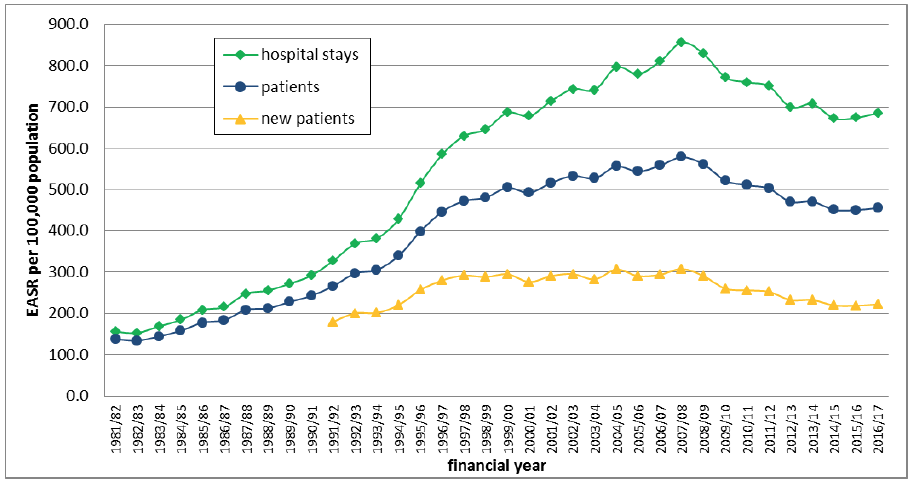
5.39. Alcohol-related hospital admissions to psychiatric hospitals have decreased since 1997/98 [105] . The age and sex adjusted rate of stays fell by 47% between 1997/98 and 2015/16 (the latest year for which data is available) from 103.0 to 54.4 stays per 100,000 population. This decrease has to be seen in the context of similar reductions having been seen for all psychiatric hospitalisations, and a shift towards an increasing amount of care for mental illness taking place in the community.
5.40. In December 2017, the Office for National Statistics introduced a new definition for calculating alcohol mortality [106] . The previous definition of alcohol-related mortality included causes which were wholly attributable, and also a very small number which were partly attributable, to alcohol misuse. The new definition includes only wholly alcohol-specific causes, i.e. deaths which are known to be a direct consequence of alcohol misuse. Previous years’ mortality numbers and rates have been restated using the new definition, but retrospective analysis by National Records of Scotland is only able to go back to 2000.
5.41. Using the previous definition, Figure 3 illustrates the peak in mortality rates that occurred in the early 2000s (42.6/100,000 for men in 2003) and a 12% increase in 2016 over the previous year. Rates for women show a peak of 19.6 deaths per 100,000 in 2006, and a 1% increase in 2016 over the previous year. This also provides comparison with the 1980s and 1990s.
Figure 3: Alcohol-related mortality rates, Scotland 1981– 2016 [107]
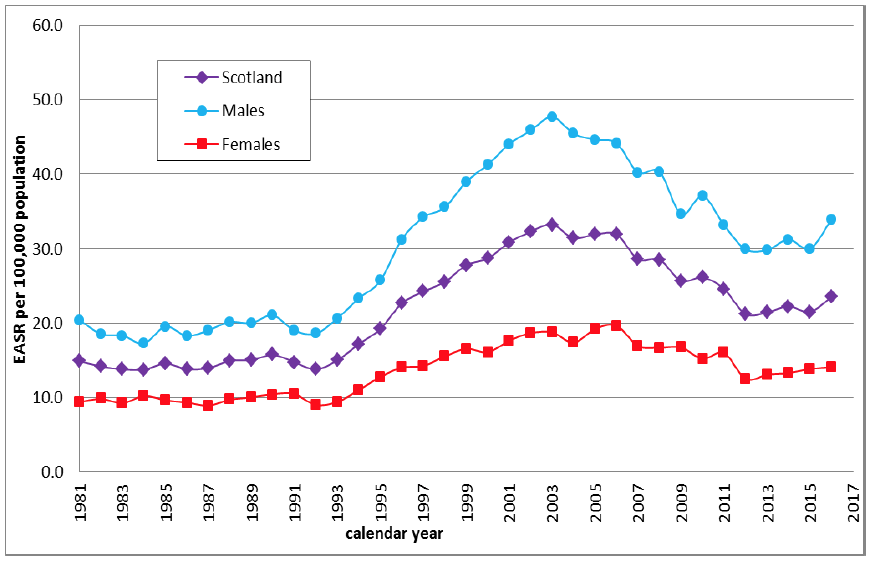
5.42. Under the new definition, there has been a 26% decrease in mortality rates from 2006 to 2016 – with an 8% increase from 2015 to 2016. (The equivalent changes under the previous definition were a 25% decrease from 2006 to 2016, and a 9% increase from 2015 to 2016.) From 1994 to 2016, under the previous definition, there has been a 41% increase in alcohol mortality. Whilst rates from 1994 have not been restated using the new definition, it is likely that the scale of the increase is similar to the 41% using the previous definition. Rates of wholly alcohol-specific mortality are therefore far higher than in the early 1990s. Figure 4 illustrates the relationship between the new (wholly alcohol-specific) and previous (alcohol-related) definitions.
Figure 4: Alcohol deaths registered in Scotland: figures based on old and new National Statistics definitions [108]
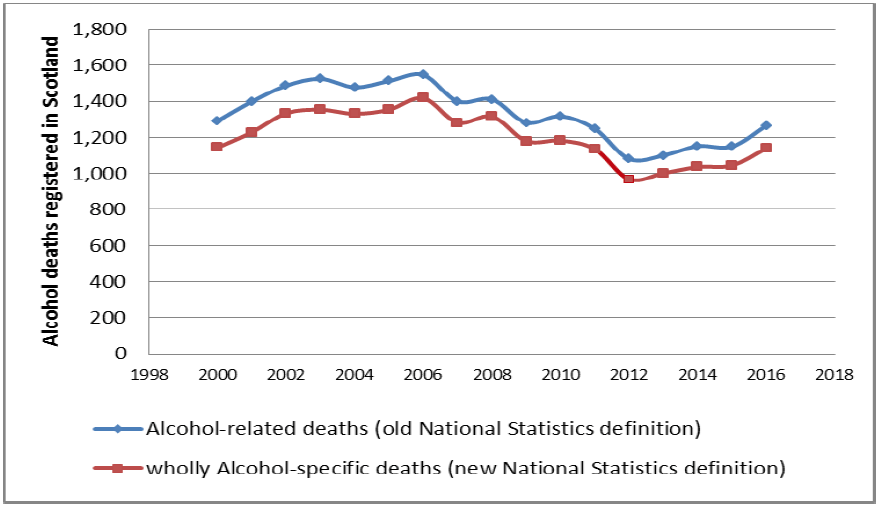
5.43. Scotland remains the country of the UK with the highest rate of wholly alcohol-specific deaths [109] . Since 2001, alcohol-specific death rates in Scotland have been higher for both sexes compared with other countries in the UK. However, Scotland has also seen the largest decrease in its rates in this time period. In particular, for males, since peaking in the early 2000s, there has been a marked decrease in rates of alcohol-specific deaths in Scotland. In particular, the rate in Scotland was 21% lower in 2016 (30.9 deaths per 100,000 males) than that observed in 2001 (39.0 deaths per 100,000 males). Despite the decrease, in 2016 the alcohol-specific deaths rate in Scotland was significantly higher than those observed in England (14.5 deaths per 100,000 males), Wales (17.4 deaths per 100,000 males) and Northern Ireland (22.2 deaths per 100,000 males).
5.44. Alcohol consumption is one of the three most common causes of Chronic Liver Disease ( CLD) [110] . In Scotland, rates of CLD and cirrhosis increased markedly and rapidly between 1982/83 and 2006/07, at a time when rates in many other European countries were falling. Rates in Scotland remained relatively stable until around 2012/13, and have since been increasing. In 2012, Scotland, along with Hungary and Finland, had the highest CLD mortality rates among countries from Central, Western, Northern and Southern Europe. Figure 5 illustrates the mortality rates in Scotland compared to those in Western Europe [111] .
Figure 5: Chronic liver disease mortality rates in Western European countries [112]
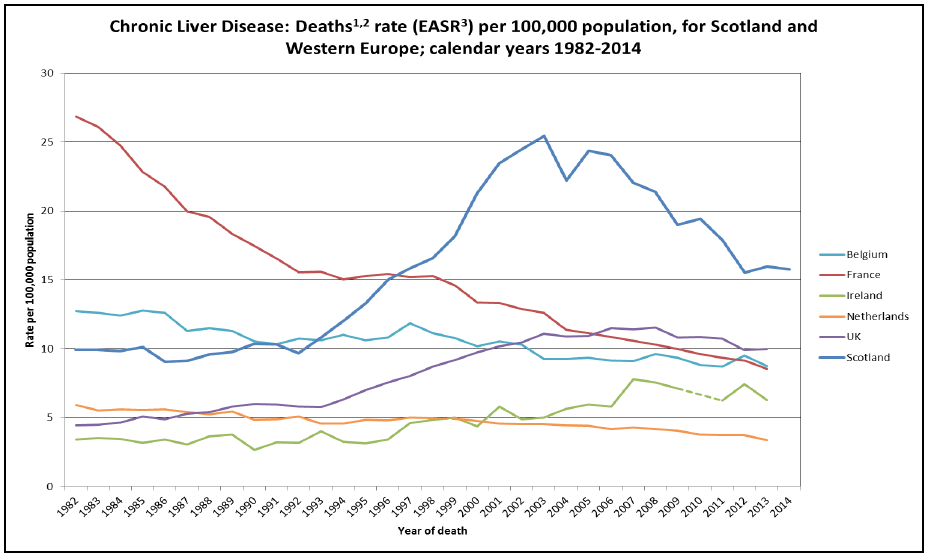
5.45. The majority of CLD mortality and morbidity in Scotland is due to alcoholic liver disease. The proportion of mortality associated with alcoholic liver disease has increased from 37% in 1979 [113] to 82% in 2015.
Inequalities in health outcomes
5.46. Although impacting on all socio-economic groups, morbidity and mortality associated with alcohol is not distributed evenly across the Scottish population. As illustrated in Figure 3, men suffer more illness and death related to alcohol than women. For CLD, rates of both morbidity and mortality are almost twice as high for men as for women [114] .
5.47. In addition, there is a strong social gradient associated with alcohol-related harm. By far the greatest harm is experienced by those who live in the most deprived areas. The reasons why alcohol has a more harmful effect on people living in deprived communities are complex and not fully understood. Risky and harmful alcohol use is likely to be both a cause and effect of social deprivation. What is clear is that the level of alcohol-related harm in deprived communities is substantial.
5.48. Relative inequalities in alcohol-related acute hospital admissions in Scotland have persisted. In 2016/17, the rate of alcohol-related hospital stays was nearly nine times higher in the 10% most deprived areas of Scotland compared with the 10% least deprived areas (as measured by the Scottish Index of Multiple Deprivation ( SIMD)) [115] . Inequalities in alcohol-related psychiatric admissions are even starker, with rates just over 15 times higher in the most deprived decile compared with the least deprived. Similarly, alcohol-related mortality rates for those aged 45-74 in 2015/16 were also nine times higher in the most deprived areas compared with the least [116] . Consistent with this, for CLD the rates were almost six times higher in the most deprived decile (34 per 100,000 population) compared to the least deprived decile (6 per 100,000).
5.49. Research suggests that the data presented in Figures 2 to 5 and discussed in this section may significantly underestimate the true scale of the problem, as they are based on cases where alcohol use is considered to be the direct cause of death. As mentioned in paragraphs 5.33 to 5.35, there are a number of causes of death and illness for which alcohol use is partly responsible [117] . A recent report [118] estimated that one in 15 deaths in Scotland in 2015 was attributable to alcohol (6.5%), and that more than one in four of these was due to cancer.
Wider alcohol-related socio-economic harm
5.50. As well as the impact on health, there are significant social and economic costs of excessive alcohol consumption. There is a long-standing body of evidence linking alcohol consumption (at both individual and population level) with crime, especially violent crime [119,120] . Many prisoners are incarcerated because of alcohol-related crime [121] . In Scotland in 2015, two in five prisoners (41%) [122] and 60% of young offenders [123] reported being drunk at the time of their offence. One in five of adult prisoners reported that drinking affected their ability to hold down a job (19%) and one third admitted that their drinking affected their relationship with their family (32%) [124] . Of those who responded to the AUDIT screening questions, almost a third (32.9%) had scores which suggested possible alcohol dependence. Nearly two thirds of young offenders (64%) said that either they, or someone else, had been injured as a result of their drinking.
5.51. The number of homicides in Scotland has been decreasing over the last decade. However, in that ten year period between 2006/07 and 2015/16, around half (48%) of all accused were reported to have been under the influence of alcohol and/or drugs at the time of the homicide. (The drug/alcohol status for the majority, 66%, is unknown). In addition, in 78% of cases where the main accused was under the influence of alcohol and/or drugs, the victim was also known to have been under the influence of alcohol and/or drugs. An Institute of Alcohol Studies report [125] concluded that 37% of ambulance time and 25% of Emergency Department Consultants’ time (in the UK) was spent dealing with alcohol-related incidents.
5.52. Although alcohol use by adolescents has been decreasing, its misuse at that age continues to put individual users and others at risk of harm. More than one third of 15 year olds (36%) who drank said that they had done something that they later regretted after drinking alcohol: 16% reported getting into trouble with the police and 17% said they had tried drugs as a consequence of drinking [126] .
5.53. As well as direct harms to the drinker, alcohol misuse results in significant psycho social harm to others. Parenting capacity is affected by alcohol use and children living with parental alcohol misuse may experience neglect or abuse [127] . Parental alcohol problems are associated with negative outcomes in children such as poorer physical and psychological health, poor educational achievement and eating disorders [128] . A UK report suggested a disproportionately large number of calls received by ChildLine from children concerned about a significant other person’s (e.g. parent, carer) drinking, were from Scotland [129] . Previous estimates suggested that between 36,000 and 51,000 children in Scotland are living with parents or guardians whose alcohol use is potentially problematic [130] .
5.54. Marriages where there are alcohol problems are twice as likely to end in divorce [131] . A quantitative research study from New Zealand demonstrated that individuals who were exposed to others’ heavy drinking (e.g. as a friend or relative) had reduced wellbeing and health status. It suggested that living with a heavy drinker may place a burden similar to being a carer for someone with a chronic illness such as Parkinson’s [132] .
5.55. Communities may suffer from antisocial behaviour fuelled by excessive alcohol consumption. In 2014, a survey found over half (60%) of people in Scotland believe alcohol is the drug which causes most problems for Scotland as a whole, compared with 19% saying heroin [133] . This has increased from 46% in 2004 and 51% in 2007.
The relationship between consumption and price: International evidence
5.56. When other factors remain unchanged, an increase in alcohol prices generally leads to a decrease in alcohol consumption, and a decrease in alcohol prices usually leads to an increase in alcohol consumption. There is a substantial body of literature indicating that increasing the price of alcohol reduces both acute and chronic harm related to drinking among people of all ages. This kind of evidence indicates that heavy or problem drinkers are no exception to the basic rule that alcohol consumers respond to changes in alcohol prices [134] . The Wagenaar [135] study, for example, considered 100 separate studies reporting over 1,000 statistical estimates over the last 30 years, and found that there was a consistent relationship between price and consumption of alcohol.
5.57. The OECD publication Tackling Harmful Alcohol Use [136] concluded, that in addition to policies aimed solely at heavy drinkers, broader policy approaches may be required as a complement to them. It advised that raising alcohol prices can improve population health, and doing so in the cheaper segment of the market may be more effective in tackling harmful drinking. One of the ten areas that the WHO has identified for national action to address the harmful use of alcohol is pricing policies [137] . Its European action plan to reduce the harmful use of alcohol 2012–2020 [138] presents several policy options to manage the affordability of alcohol. These include increasing alcohol taxes, introducing a legal minimum price per litre of alcohol, and restricting the use of direct and indirect price promotions.
5.58. A recent systematic review assessing the evidence for the effectiveness of minimum pricing of alcohol concluded that “... price based policy interventions such as MUP are likely to reduce alcohol consumption, alcohol-related morbidity and mortality” [139] .
5.59. In Switzerland in 1999, a 30% to 50% reduction in taxation on foreign spirits led to a 28% increase in consumption of spirits. There was no significant change in the consumption of wine or beer [140] . In Finland in 2004, reduced tax on alcohol (by one third) and increased access to much cheaper alcohol from Estonia, offered a ‘natural experiment’ on the impact of taxation and price on drinking and harm. Following the change, liver cirrhosis deaths rose by 30% in just one year, as alcohol consumption increased by 10% [141] . A 2012 study further found significantly increased mortality among harmful drinkers after the price reductions of 2004 [142] . Room et al [143] similarly found that alcohol attributable harms increased in Finland after the 2004 change, especially in people with low socio-economic status. The authors also found that the impact of tax changes in Denmark and the opening up of borders across the Nordic countries, all of which happened at the same time as the Finnish tax rises, were dampened in the more affluent countries.
5.60. Finland subsequently reversed the fiscal policy in 2008, raising taxes by 15% for strong alcoholic beverages and by 10% for other alcoholic beverages, with further tax increases in 2009. Total consumption of alcoholic beverages fell by around 2%, there was a 5% reduction in alcohol-related periods of care in hospital and a drop in the number of alcohol-related deaths. These trends continued in 2010, with a 2% decrease in consumption, an 8% reduction in alcohol-related periods of hospital care and 189 fewer alcohol-related deaths [144] .
5.61. Russia, and the former USSR, have long had high levels of alcohol-related health harm. A study found that variation in vodka prices, both over time and geographically, closely matches variation in mortality [145] . A minimum price for vodka was introduced in Russia in 2009, and minimum prices for alcohol products also now exist in Belarus, Kyrgyzstan, the Republic of Moldova and Ukraine [146] .
5.62. Minimum alcohol pricing has been used in some Canadian provinces since the 1920s and is now in place, to some degree, in all ten provinces. Research findings from Canada provide empirical evidence of the effectiveness of minimum pricing in reducing consumption [147] , alcohol-related morbidity [148] and mortality, where a 10% increase in average minimum price for all alcoholic beverages was associated with a 32% reduction in wholly alcohol attributable deaths [149] . More recent studies have found that increases in minimum alcohol prices produce greater impacts on alcohol-related hospitalisations in areas of low income (where the rates of harm are known to be greater) [150] and may contribute to reductions in certain types of crime: in this study [151] , alcohol-related traffic offences and violent crimes carried out by men.
Consumption, price and affordability: Scottish data
5.63. In 2016, alcohol sales in Scotland were 15% higher than in 1994. As can be seen in Figure 6, this increase is driven by off-trade sales, which are 61% higher than in 1994.
Figure 6 : Volume of pure alcohol (litres) sold per adult (16+) Scotland and England & Wales, by trade sector, 1994–2016 [152]
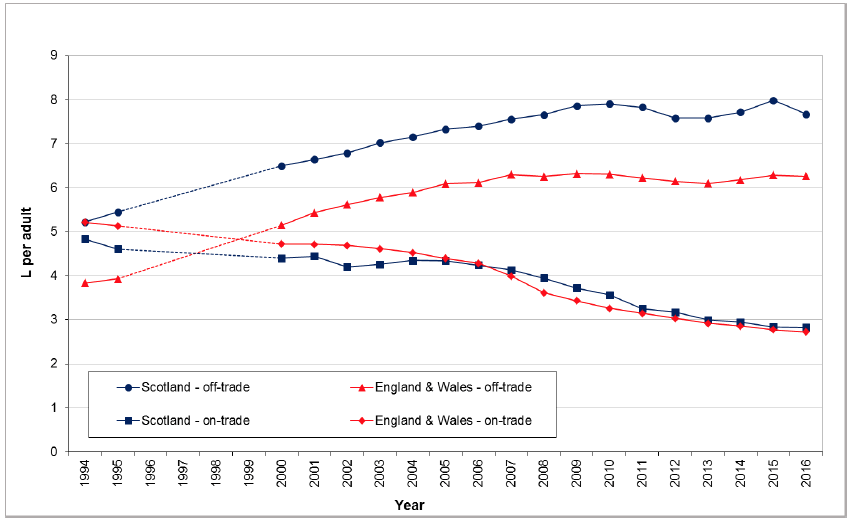
5.64. In 2016, 73% of all alcohol sold in Scotland was sold through the off-trade (supermarkets and other off-licences) compared with 27% sold through the on-trade (such as pubs, clubs and restaurants) [153] .
5.65. There is a considerable price differential between the on and off-trade sectors in Scotland. In 2016, the average price per unit of alcohol was 53 pence in the off-trade and £1.79 in the on-trade [154] . Since 2000, on-trade prices have been steadily increasing, in contrast to those in the off-trade where, although there was some increase between 2007 and 2013, prices have been fairly flat. This can be seen in Figure 7.
Figure 7: Price per unit of alcohol in Scotland and England & Wales, by trade sector, 1994-2016
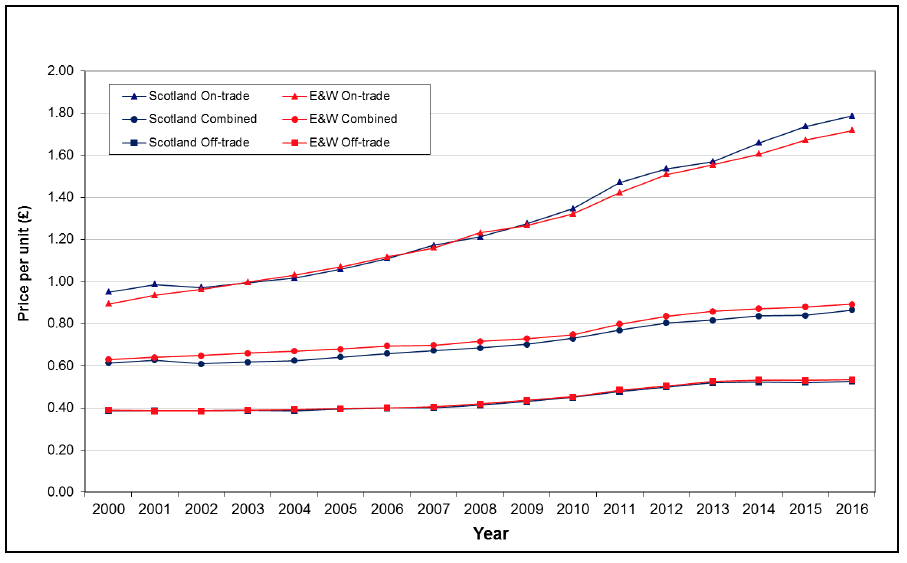
5.66. The on-trade has experienced an 88% increase in average price per unit since 2000, whilst in the off-trade the increase is 36%. Notably, the difference in average price between the two sectors has increased by 124%.
5.67. Whilst average price is one indication of what is happening in the market, when considering the potential impact of minimum pricing it is necessary to examine the distribution of price. Data from the Nielsen Company [156] on the price of alcohol sold through the off-trade have been published annually by NHS Health Scotland since 2010. Nielsen obtain weekly price data from most large multiple retailers and a stratified random sample of independent and smaller multiple retailers [157,158,159] .
5.68. The 2016 data show that there is still a considerable amount of alcohol sold cheaply within the off-trade in Scotland. Figure 8 illustrates that 10% of all alcohol (as measured by volume of pure alcohol) in the off-trade was sold at less than 35p per unit; 39% at less than 45p per unit and just over half (51%) at less than 50p per unit [160] .
Figure 8: Price distribution (%) of pure alcohol sold off-trade in Scotland, 2016 [161]
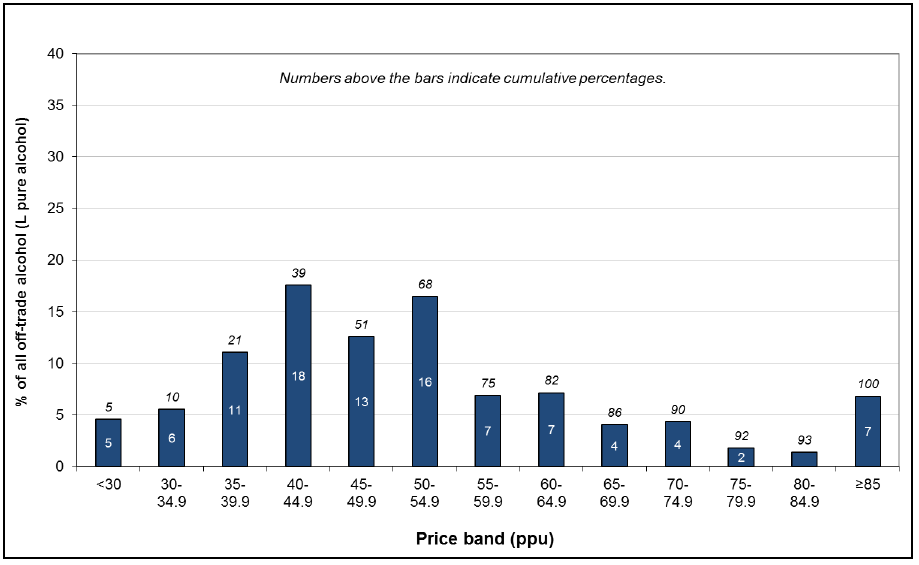
5.69. The price distribution varies with different products. In 2016, in Scotland:
- 15% of vodka was sold at below 35p per unit, 72% below 50p per unit;
- <1% of whisky was sold at below 35p per unit, 59% below 50p per unit;
- 3% of wine was sold at below 35p per unit, 29% below 50p per unit;
- 20% of beer was sold at below 35p per unit, 64% below 50p per uni;t
- 44% of cider was sold at below 35p per unit, 71% below 50p per unit.
5.70. This implies that, for example, 72% of vodka was sold at less than £13.13 for a 70cl bottle (assuming ABV of 37.5%), and that 44% of cider retailed at the equivalent of £1.75 for 1 litre at 5% strength.
5.71. Whilst Figure 7 illustrates that the average price in the off-trade had been relatively stable, Figure 9 shows how the price distribution has been shifting to the right during the period 2009-2016. This means that, for any given price per unit (e.g. 50p per unit), the amount sold below that is diminishing over time. At the lower end of the distribution, in 2009, 14% of alcohol was sold at less than 30p; in 2016 it was 5%, and 77% was sold under 50p per unit in 2009, compared with 51% in 2016. Conversely, at the top end of the market, in 2009, only 2% of alcohol was sold at 85p per unit or dearer; in 2016, that had grown to 7%.
5.72. The changing shape of the distribution (from a broadly normal distribution to a bimodal one) shows the impact of substantial numbers of products clustering around price points, e.g. a bottle of spirits ( ABV 37.5%) retailing at £11 is equivalent to 42p per unit, and a bottle of wine ( ABV 12.5% ) retailing at £5 is equivalent to 53p per unit.
Figure 9: Price distribution (%) of pure alcohol sold off-trade in Scotland, 2009-2016 [162]
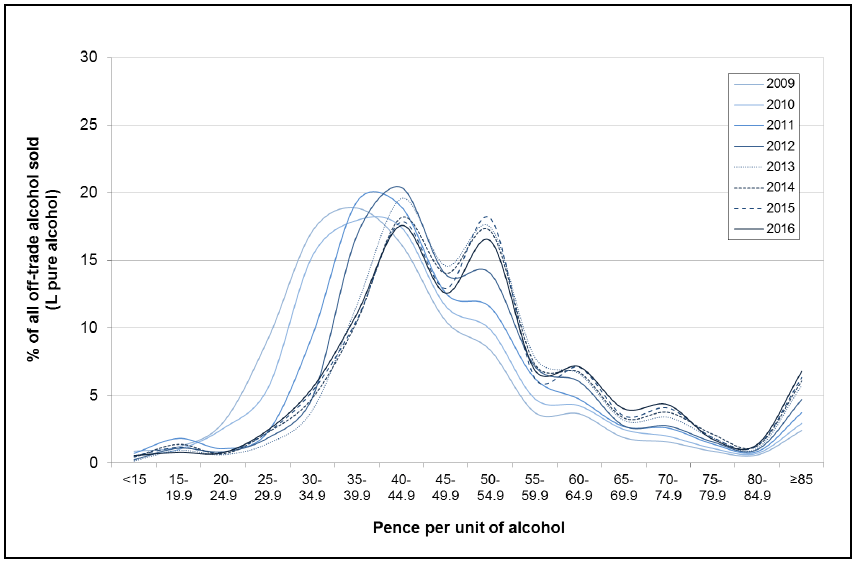
5.73. The sales data already illustrated in Figure 6 show the disparity between consumption in Scotland and England & Wales. The price distribution data allow further analysis. As in previous years, the difference is driven by the off-trade, with 93% of the total difference in per adult sales between Scotland and England & Wales in 2016 being due to higher off-trade sales in Scotland.
5.74. Figure 10 further illustrates that much of this difference is driven by higher sales of cheap alcohol. NHS Health Scotland analysis found that 63% of the off-trade difference was due to higher per adult sales of spirits in Scotland [163] . Vodka explains 36% of the difference in off-trade sales, with per adult sales via off-trade in Scotland more than twice that of England (2.1 times higher).
Figure 10: Price distribution (L per adult) of pure alcohol sold off-trade in Scotland and England & Wales, 2016 [164]
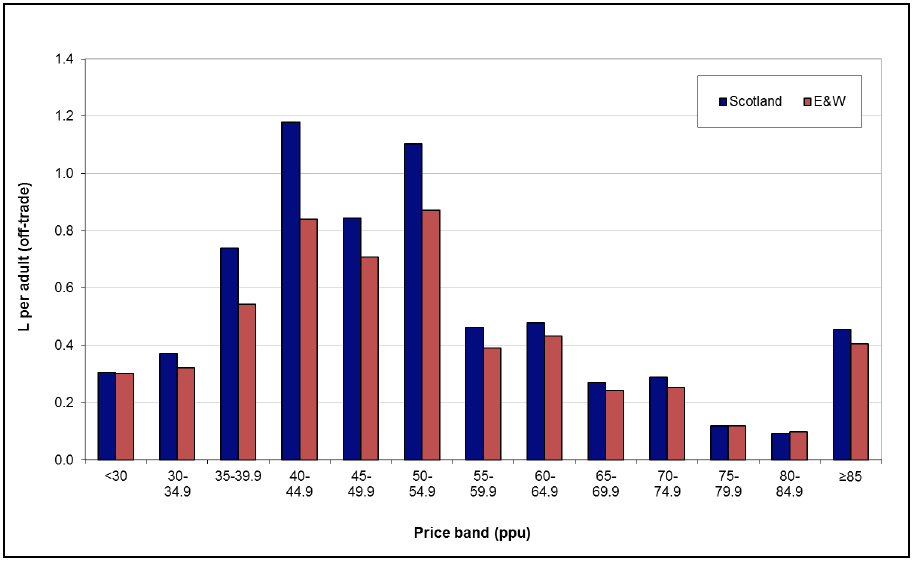
5.75. Price is a key component of affordability, and it is relative affordability that drives consumption. In real terms, alcohol sold in the UK was 60% more affordable in 2015 than it was in 1980. However, changes in affordability have not been uniform across sectors or drink types. Affordability in the on-trade sector has increased little over the period in contrast to off-trade products, as seen in Figure 11.
Figure 11: Drink type-specific alcohol affordability, United Kingdom, 2000-2015 [165]
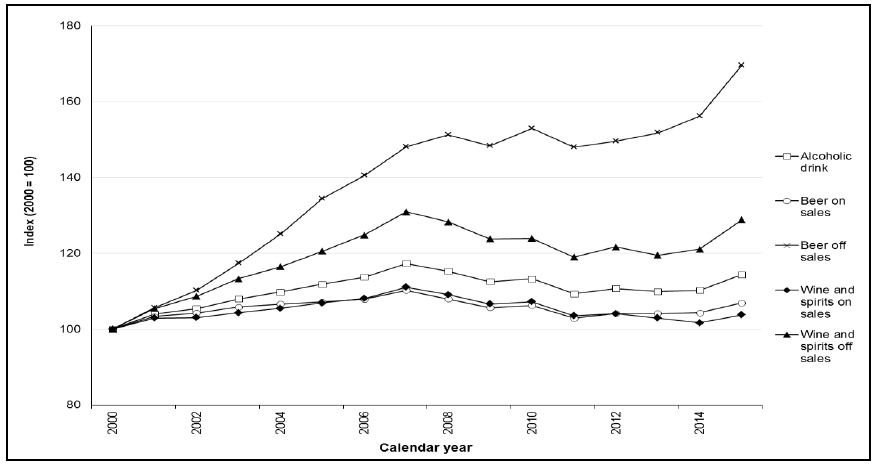
Contact
There is a problem
Thanks for your feedback